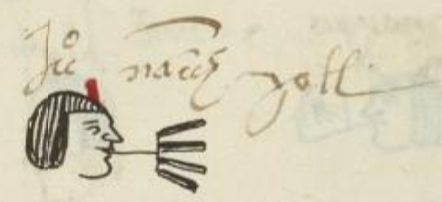Nauhyotl (MH810r)
This black-line drawing of the simplex glyph for the personal name Nauhyotl ("Fourness," "Having the Quality of Four," or maybe "Symmetry") is attested here as a man’s name. The glyph shows four black and white thin rectangular shapes, something like sticks, all rather horizontal but fanning out from a line that connects them. These are also connected by a line from the tribute payer’s mouth, as the contextualizing image shows.
Stephanie Wood
Nauhyotl is a popular name in this collection, as some of the examples show (below). The number four can consist of four small circles, four lines, or four sticks somewhat like these. Having a white line alongside the black is, however, unusual.
There was a Nauhyotl Tecuhtli, the Lord of the Four Directions. So, perhaps Nauhyotl and Nauhyotzin were shorter versions of this, or perhaps they also had some connection with cardinal directions.
The seventh ruler of Culhuacan had the name Nauhyotl Tecuhtlamacazqui. The simpler name Nauhyotl is further attested in at least a couple of censuses for various men after colonization.
The even numbers four and eight were pervasive in Nahua culture. The suffix "-yotl" is, according to James Lockhart, "an abstract or collective nominal suffix that, when possessed, expresses inalienable or organic possession" (see his: Nahuatl as Written: Lessons in Older Written Nahuatl, with Copious Examples and Texts, Stanford: Stanford University Press and UCLA Latin American Studies, 2001, 242). In English, this can be something like the suffix -ness, or -ship, or refer to a design of the type mentioned in the noun. One might think of nauhyotl as referring to a quatrefoil, but the visual is very basic, seeming relating to counting, and nothing like the four-division shield or the shape of the sun. Of course, a drawing of that sort could lead to an incorrect reading. Here, the tlacuilo wished to convey the number and its meaning.
Notice how some tonalli (sun, day, solar energizing force) signs can appear as four circles (below).
Guy Stresser-Péan (1995, 150) suggests "abstracción del número cuatro" as the translation of Nauhyotl. (See our Bibliography for the full citation of his book.) Magnus Pharao Hansen translates Nauhyotl as "Fourth," in his 2014 blog about the 1544 census of Morelos.
Some names that are simply numbers, such as macuilli (expressed as Macuil), may have originally been names from the divinatory calendars, having had this number, one of the thirteen, in combination with one of twenty day signs. But, here, the -yotl suffix takes the number name more toward an emphasis on just the number itself and probably its symmetry. Omeyotl (duality) is another example, although it is less popular as a personal name than Nauhyotl.
Stephanie Wood
1560
Jeff Haskett-Wood
numbers, números, names, nombres de hombres

Nauhyotl, a personal name, https://nahuatl.wired-humanities.org/content/nauhyotl
nahui, four, https://nahuatl.wired-humanities.org/content/nahui
-yotl, having the nature of, https://nahuatl.wired-humanities.org/content/yotl
La Calidad o Naturaleza de Cuatro, Cuatredad
Stephanie Wood
Matrícula de Huexotzinco, folio 810r, World Digital Library, https://www.loc.gov/resource/gdcwdl.wdl_15282/?sp=694&st=image.
This manuscript is hosted by the Library of Congress and the World Digital Library; used here with the Creative Commons, “Attribution-NonCommercial-ShareAlike 3.0 License” (CC-BY-NC-SAq 3.0).













